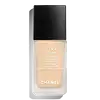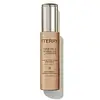What's inside
What's inside
 Key Ingredients
Key Ingredients

 Benefits
Benefits

 Concerns
Concerns

 Ingredients Side-by-side
Ingredients Side-by-side

Water
Skin ConditioningDimethicone
EmollientIsododecane
EmollientTrimethylsiloxysilicate
EmollientGlycerin
HumectantButylene Glycol
HumectantPEG/PPG-18/18 Dimethicone
EmulsifyingPolymethylsilsesquioxane
Polyglyceryl-3 Diisostearate
EmulsifyingDisteardimonium Hectorite
StabilisingTribehenin
EmollientMagnesium Sulfate
Tocopheryl Acetate
AntioxidantPotassium Sorbate
PreservativeXanthan Gum
EmulsifyingChlorphenesin
AntimicrobialPropylene Carbonate
SolventTriethoxycaprylylsilane
Aluminum Hydroxide
EmollientParfum
MaskingCI 77007
Cosmetic ColorantCI 77491
Cosmetic ColorantCI 77492
Cosmetic ColorantCI 77499
Cosmetic ColorantCI 77891
Cosmetic ColorantMica
Cosmetic ColorantWater, Dimethicone, Isododecane, Trimethylsiloxysilicate, Glycerin, Butylene Glycol, PEG/PPG-18/18 Dimethicone, Polymethylsilsesquioxane, Polyglyceryl-3 Diisostearate, Disteardimonium Hectorite, Tribehenin, Magnesium Sulfate, Tocopheryl Acetate, Potassium Sorbate, Xanthan Gum, Chlorphenesin, Propylene Carbonate, Triethoxycaprylylsilane, Aluminum Hydroxide, Parfum, CI 77007, CI 77491, CI 77492, CI 77499, CI 77891, Mica
Water
Skin ConditioningDimethicone
EmollientCI 77891
Cosmetic ColorantIsododecane
EmollientPEG/PPG-18/18 Dimethicone
EmulsifyingPolyethylene
AbrasivePropylene Glycol Dicaprylate/Dicaprate
EmollientGlycerin
HumectantIsohexadecane
EmollientButylene Glycol
HumectantDivinyldimethicone/Dimethicone Crosspolymer
Skin ConditioningBoron Nitride
AbsorbentSodium Citrate
BufferingMethyl Methacrylate Crosspolymer
CI 77492
Cosmetic ColorantCaprylyl Methicone
Skin ConditioningMica
Cosmetic ColorantTocopherol
AntioxidantDextrin Palmitate
EmulsifyingPhenoxyethanol
PreservativeCI 77491
Cosmetic ColorantParaffinum Liquidum
EmollientTalc
AbrasiveHdi/Trimethylol Hexyllactone Crosspolymer
Pentylene Glycol
Skin ConditioningGlycine Soja Oil
EmollientParfum
MaskingAluminum Hydroxide
EmollientTriethoxycaprylylsilane
CI 77499
Cosmetic ColorantLauroyl Lysine
Skin ConditioningMethylparaben
PreservativeTetrasodium EDTA
Polymethyl Methacrylate
Hibiscus Abelmoschus Extract
MaskingDehydroacetic Acid
PreservativeSilica
AbrasiveLimonene
PerfumingXanthan Gum
EmulsifyingHexyl Cinnamal
PerfumingLinalool
PerfumingPalmitic Acid
EmollientBenzyl Salicylate
PerfumingHydroxycitronellal
PerfumingAlpha-Isomethyl Ionone
PerfumingGeraniol
PerfumingEugenol
PerfumingWater, Dimethicone, CI 77891, Isododecane, PEG/PPG-18/18 Dimethicone, Polyethylene, Propylene Glycol Dicaprylate/Dicaprate, Glycerin, Isohexadecane, Butylene Glycol, Divinyldimethicone/Dimethicone Crosspolymer, Boron Nitride, Sodium Citrate, Methyl Methacrylate Crosspolymer, CI 77492, Caprylyl Methicone, Mica, Tocopherol, Dextrin Palmitate, Phenoxyethanol, CI 77491, Paraffinum Liquidum, Talc, Hdi/Trimethylol Hexyllactone Crosspolymer, Pentylene Glycol, Glycine Soja Oil, Parfum, Aluminum Hydroxide, Triethoxycaprylylsilane, CI 77499, Lauroyl Lysine, Methylparaben, Tetrasodium EDTA, Polymethyl Methacrylate, Hibiscus Abelmoschus Extract, Dehydroacetic Acid, Silica, Limonene, Xanthan Gum, Hexyl Cinnamal, Linalool, Palmitic Acid, Benzyl Salicylate, Hydroxycitronellal, Alpha-Isomethyl Ionone, Geraniol, Eugenol
Ingredients Explained
These ingredients are found in both products.
Ingredients higher up in an ingredient list are typically present in a larger amount.
Aluminum Hydroxide is a form of aluminum. It can be naturally found in nature as the mineral gibbsite. In cosmetics, Aluminum Hydroxide is used as a colorant, pH adjuster, and absorbent.
As a colorant, Aluminum Hydroxide may add opacity, or reduce the transparency. Aluminum hydroxide is contains both basic and acidic properties.
According to manufacturers, this ingredient is an emollient and humectant. This means it helps hydrate the skin.
In medicine, this ingredient is used to help relieve heartburn and help heal ulcers.
There is currently no credible scientific evidence linking aluminum hydroxide in cosmetics to increased cancer risk.
Major health organizations allow the use of aluminum hydroxide in personal care products and have not flagged it as a carcinogenic risk at typical usage levels.
Learn more about Aluminum HydroxideButylene Glycol (or BG) is used within cosmetic products for a few different reasons:
Overall, Butylene Glycol is a safe and well-rounded ingredient that works well with other ingredients.
Though this ingredient works well with most skin types, some people with sensitive skin may experience a reaction such as allergic rashes, closed comedones, or itchiness.
Learn more about Butylene GlycolCi 77491 is also hydrated iron III oxide. It's sole purpose is to give a red/pink hue to products.
Iron III oxides are classified as inorganic chemicals for coloring.
Synthetically created Ci 77491 is considered safer than those naturally found. This is because the synthetically created version may contain less impurities. Iron oxides are generally non-toxic and non-allergenic.
Learn more about CI 77491Ci 77492 is also hydrated iron III oxide. It's sole purpose is to give a yellow hue to products.
Iron III oxides are classified as inorganic chemicals for coloring.
Synthetically created Ci 77492 is considered safer than those naturally found. This is because the synthetically created version may contain less impurities. Iron oxides are generally non-toxic and non-allergenic.
Learn more about CI 77492Ci 77499 is also hydrated iron III oxide. It is created from mixing red and black iron oxides. This helps give shades of darkness to a product.
Iron III oxides are classified as inorganic chemicals for coloring.
Ci 77891 is a white pigment from Titanium dioxide. It is naturally found in minerals such as rutile and ilmenite.
It's main function is to add a white color to cosmetics. It can also be mixed with other colors to create different shades.
Ci 77891 is commonly found in sunscreens due to its ability to block UV rays.
Learn more about CI 77891Dimethicone is a type of synthetic silicone created from natural materials such as quartz.
What it does:
Dimethicone comes in different viscosities:
Depending on the viscosity, dimethicone has different properties.
Ingredients lists don't always show which type is used, so we recommend reaching out to the brand if you have questions about the viscosity.
This ingredient is unlikely to cause irritation because it does not get absorbed into skin. However, people with silicone allergies should be careful about using this ingredient.
Note: Dimethicone may contribute to pilling. This is because it is not oil or water soluble, so pilling may occur when layered with products. When mixed with heavy oils in a formula, the outcome is also quite greasy.
Learn more about DimethiconeGlycerin is already naturally found in your skin. It helps moisturize and protect your skin.
A study from 2016 found glycerin to be more effective as a humectant than AHAs and hyaluronic acid.
As a humectant, it helps the skin stay hydrated by pulling moisture to your skin. The low molecular weight of glycerin allows it to pull moisture into the deeper layers of your skin.
Hydrated skin improves your skin barrier; Your skin barrier helps protect against irritants and bacteria.
Glycerin has also been found to have antimicrobial and antiviral properties. Due to these properties, glycerin is often used in wound and burn treatments.
In cosmetics, glycerin is usually derived from plants such as soybean or palm. However, it can also be sourced from animals, such as tallow or animal fat.
This ingredient is organic, colorless, odorless, and non-toxic.
Glycerin is the name for this ingredient in American English. British English uses Glycerol/Glycerine.
Learn more about GlycerinIsododecane is a fragrance, emollient, and solvent.
As an emollient, it helps your skin stay soft and hydrated. Emollients help trap moisture into your skin.
Isododecane's role as a solvent makes it a great texture enhancer. It spreads smoothly on skin and does not leave a sticky feeling behind. Isododecane also helps prevent color transfer in makeup products.
Isododecane is not absorbed into skin.
Learn more about IsododecaneMica is a naturally occurring mineral used to add shimmer and color in cosmetics. It can also help improve the texture of a product or give it an opaque, white/silver color.
Serecite is the name for very fine but ragged grains of mica.
This ingredient is often coated with metal oxides like titanium dioxide. Trace amounts of heavy metals may be found in mica, but these metals are not harmful in our personal products.
Mica has been used since prehistoric times throughout the world. Ancient Egyptian, Indian, Greek, Roman, Aztec, and Chinese civilizations have used mica.
Learn more about MicaParfum is a catch-all term for an ingredient or more that is used to give a scent to products.
Also called "fragrance", this ingredient can be a blend of hundreds of chemicals or plant oils. This means every product with "fragrance" or "parfum" in the ingredients list is a different mixture.
For instance, Habanolide is a proprietary trade name for a specific aroma chemical. When used as a fragrance ingredient in cosmetics, most aroma chemicals fall under the broad labeling category of “FRAGRANCE” or “PARFUM” according to EU and US regulations.
The term 'parfum' or 'fragrance' is not regulated in many countries. In many cases, it is up to the brand to define this term.
For instance, many brands choose to label themselves as "fragrance-free" because they are not using synthetic fragrances. However, their products may still contain ingredients such as essential oils that are considered a fragrance by INCI standards.
One example is Calendula flower extract. Calendula is an essential oil that still imparts a scent or 'fragrance'.
Depending on the blend, the ingredients in the mixture can cause allergies and sensitivities on the skin. Some ingredients that are known EU allergens include linalool and citronellol.
Parfum can also be used to mask or cover an unpleasant scent.
The bottom line is: not all fragrances/parfum/ingredients are created equally. If you are worried about fragrances, we recommend taking a closer look at an ingredient. And of course, we always recommend speaking with a professional.
Learn more about ParfumPEG/PPG-18/18 Dimethicone is a type of silicone.
Triethoxycaprylylsilane is a silicone used to bind and stabilize ingredients.
As an emulsifier, it helps prevent ingredients from separating. This can help elongate the shelf life of products.
Triethoxycaprylylsilane is often used to coat mineral sunscreens ingredients to help give a better feel. It also helps reduce oxidative stress in sunscreens.
Learn more about TriethoxycaprylylsilaneWater. It's the most common cosmetic ingredient of all. You'll usually see it at the top of ingredient lists, meaning that it makes up the largest part of the product.
So why is it so popular? Water most often acts as a solvent - this means that it helps dissolve other ingredients into the formulation.
You'll also recognize water as that liquid we all need to stay alive. If you see this, drink a glass of water. Stay hydrated!
Learn more about WaterXanthan gum is used as a stabilizer and thickener within cosmetic products. It helps give products a sticky, thick feeling - preventing them from being too runny.
On the technical side of things, xanthan gum is a polysaccharide - a combination consisting of multiple sugar molecules bonded together.
Xanthan gum is a pretty common and great ingredient. It is a natural, non-toxic, non-irritating ingredient that is also commonly used in food products.
Learn more about Xanthan Gum